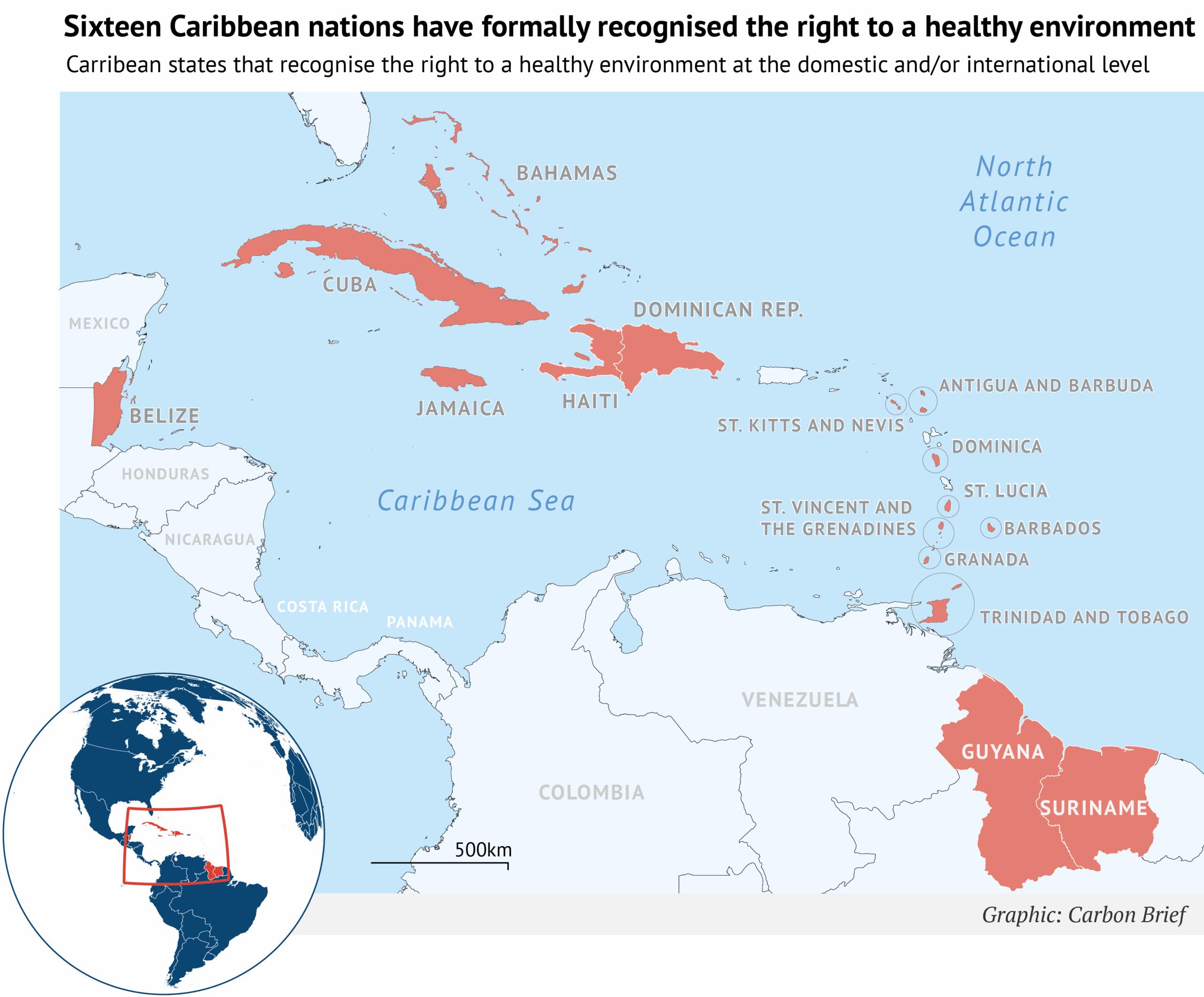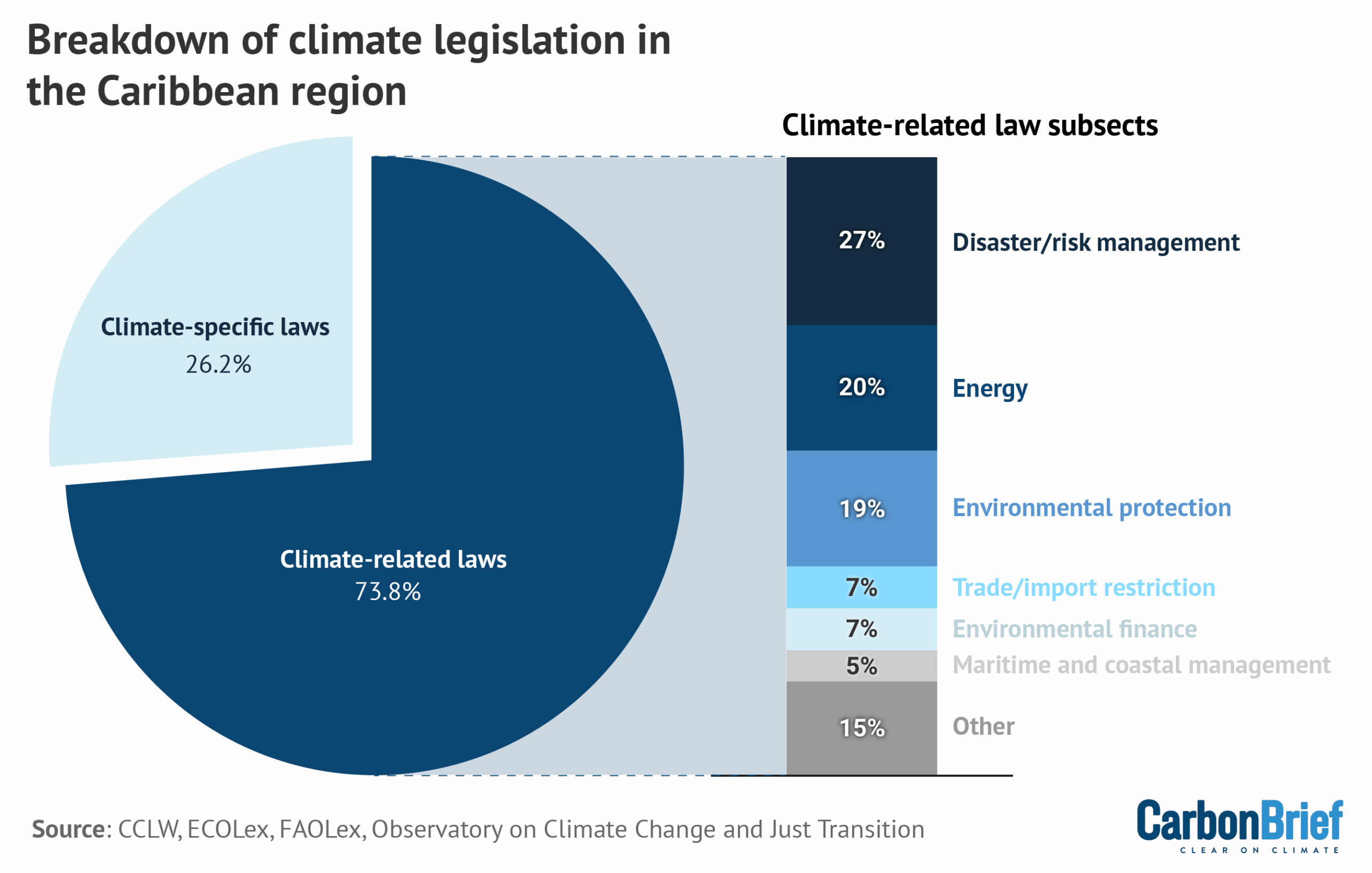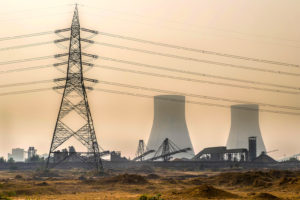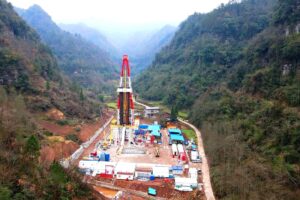Long-abolished discriminatory lending practices in the US are still having an impact on the inequality of climate risks facing urban populations today, according to a new study.
The research, published in Nature Cities, looks at historically “redlined” neighbourhoods – those deemed highly risky for lenders, broadly due to the race and economic profile of those in the area – and compares them to neighbourhoods that were seen as less risky.
The scientists find that, across more than 200 US cities, once-redlined neighbourhoods are at higher risk of heat exposure and flooding.
Even homes just tens of metres apart have different climate risks, they find, with those located on the redlined side of a boundary at higher risk than those living on the other side of the boundary.
The lead author of the study tells Carbon Brief that the work underscores the historical legacy of planning decisions made in the last century, adding that she hopes that current policymakers can better consider the “impact of different planning policies and the unintended consequences”.
One researcher who was not involved in the study tells Carbon Brief that the work makes several significant contributions, but cautions that the authors were “pretty bold” in some of their conclusions.
‘Risky’ investments
“Redlining” refers to a discriminatory historical practice in the US, whereby neighbourhoods were graded as too “risky” for investment based on race, income levels and housing quality. These grades were used as justification for the denial of long-term mortgages and exacerbated existing racial segregation.
One of the most recognisable remnants of redlining is the set of maps produced by the Home Owners’ Loan Corporation (HOLC), established in 1933 as part of US president Franklin D Roosevelt’s “New Deal”. The HOLC refinanced foreclosed mortgages at lower interest rates with the intention of preserving and expanding homeownership.
The HOLC created maps of “riskiness” of investment in an attempt to guarantee that the loans would be paid back and that the burden on the taxpayer would be minimal.
The maps created by the HOLC classified neighbourhoods based on a four-point risk scale, with A-grades – the “best”, or least-risky, investments – outlined in green and D-grades – the most risky, termed “hazardous” – outlined in red, giving rise to the term.
B-graded neighbourhoods, outlined in blue, were termed “still desirable”, while C-graded ones, in yellow, were “declining”.

The HOLC created maps for more than 200 cities across at least 40 states. Other federal agencies and private companies later made their own “risk-assessment” maps, further cementing the practice into policy.
Although redlining was formally outlawed in 1968 by the US Fair Housing Act, the inequalities created and exacerbated by the practice persist in many places to this day, says Dr Arianna Salazar-Miranda, an urban planner and data scientist at Yale University.
Salazar-Miranda, who is the lead author of the new study, tells Carbon Brief:
“There are many social and economic dimensions for which we should be worried about this long-standing legacy of redlining.”
For example, previous research has shown that redlined neighbourhoods have lower rates of homeownership, lower credit scores and lower home values. There are also associations between historically redlined neighbourhoods and prevalence of cancer and asthma, air pollution and proximity to hazardous waste, among other dimensions of health inequality and environmental racism.
Prof Shannon Van Zandt, an urban planner at Texas A&M University, who was a reviewer of the new paper, but not involved in the study itself, tells Carbon Brief:
“Segregation is still so relevant in the experiences of families of colour and, in particular, Black or African American households, because of the very indelible lines that we literally drew [on the map].”
Climate risk
Using maps from 202 cities across the US, Salazar-Miranda and her colleagues examine the risk of heat extremes and flooding for homes in differently graded neighbourhoods. These factors, each graded on a 1-10 scale from least to most hazardous, were developed by the climate research and technology firm First Street.
The heat risk factor combines temperature and humidity to determine a “feels-like” temperature, averaged across the month of July for each location.
The flood risk factor uses flooding factors, such as rainfall and high tide levels, as well as variables that affect water runoff, including elevation and ground permeability. It also incorporates existing community flood defences. The risk is defined by both depth and likelihood of flooding.
Both the heat and flood risk scores also factor in projections of future climate change, including higher temperatures and sea level rise.
The researchers focused specifically on homes within 100 metres of a boundary between two different grades. Salazar-Miranda tells Carbon Brief:
“We’re trying to narrow down on a subset of properties that are very comparable, where they have the same underlying conditions and the only thing that changed is whether they’re on one side of the border or the other.”
The maps below show the digitised redlining map of Baltimore (left), with the colours indicating the different grades and the bold lines depicting boundaries between different grades.
On the right, a zoomed-in portion of the map shows the 100-metre buffer zones drawn around each boundary. Locations of houses are coloured according to which side of the border they fall on – grey for the lower-graded side and black for the higher-graded side.

Geographical and climatic features, such as elevation and amount of rainfall, did not vary significantly across the boundaries because the researchers were only looking at homes close to a grade boundary.
They find that, aggregated across all cities, D-graded neighbourhoods have a flood risk factor that is 0.245 points higher than A-graded ones – more than three times higher than the additional risk of a C-graded neighbourhood.
The heat risk effect is smaller, but still significant, with D-graded neighbourhoods scoring 0.033 points higher than A-graded neighbourhoods.
The chart below shows the flood and heat exposure risks for neighbourhoods graded B, C and D, relative to the average risk for A-graded neighbourhoods. While both risk factors increase as the grade decreases, the effect is much more pronounced for flood risk.

They also find that flood risk factor increases by 0.1 points, or about 5.5% on average, for homes that are on the lower-graded side of a border, as compared to homes on the higher-graded sides. For the heat risk factor, this figure is 0.011 points.
Although the absolute change in the heat risk factor is relatively small, Salazar-Miranda tells Carbon Brief that these “very small changes…can really harm your health”. She adds:
“It really depends on your pre-determinants of health – how healthy you are, how well you eat, whether you have diabetes or an underlying health condition. And we know that these are particularly worse in disadvantaged communities.”
Doing the analysis on a parcel-scale – namely, house-by-house – is one of the most significant contributions of the new work, says Prof Vivek Shandas, a professor of geography focusing on urban climate at Portland State University in Oregon, who was not involved in the new research. However, Shandas adds:
“There’s a lot that happens across 200 or 100 metres in a city…If we’re doing parcel-scale assessments, we need to get parcel-scale understanding of movement of water and the way that heat is distributed.”
‘Environmental capital’
The researchers then investigate a potential mechanism for how historical redlining could still be impacting vulnerability to current and future climate risks.
They propose that lower-graded neighbourhoods had less investment in what they call “environmental capital”, such as trees, public parks and drainage systems.
This, they say, could be due to a combination of factors: lower property values in the neighbourhoods reduces the communities’ tax income that could be invested in such projects; places with high levels of income inequality tend to have lower community engagement; and low homeownership rates can lead to reduced community investment in public goods, such as parks.
As a proxy for environmental capital investment, the authors look at four measurable factors of environmental quality: tree canopy, street-level vegetation, ground-surface perviousness and home foundation height. Tree cover and street-level vegetation can both mitigate heat risk by providing shade and inducing a cooling effect. More pervious ground surfaces allow more drainage, while higher foundations can decrease an individual home’s risk of flooding.
They find that for each measure of environmental quality, lower-graded neighbourhoods score progressively worse than higher-graded ones, as seen in the chart below.

Houses in D-graded neighbourhoods are, on average, nearly 5.7 percentage points less pervious and have 3.4 percentage points less tree cover than those in A-graded areas.
Similarly, homes on the lower-graded side of a border have lower perviousness and foundations closer to the ground level than homes on the higher-graded side, by 1.9 and 2 percentage points, respectively. Tree canopy and street-level vegetation differ between the two by 1.03 and 1.2 percentage points.
Shandas tells Carbon Brief that introducing the idea of capital into this type of analysis is “really interesting”, but the claims the authors make about their proposed mechanism are “pretty bold”. He adds:
“Each city is so unique…We can find an association, but getting a mechanism has to be [on] a case-by-case basis.”
Van Zandt adds that the redlined maps are a “good proxy”, but not necessarily the driver of inequity. The important part, she says, is “that we identified neighbourhoods that banks should not invest in – and that those patterns persist to today”.
Lived experience
Given the disparities identified in the work, Salazar-Miranda says she hopes that policymakers can incorporate this type of information into funding and other policy decisions. As an added benefit, she says, many of the investments in environmental capital – such as additional green spaces – can improve mental and physical well-being. She adds:
“One of the conversations that would be interesting, from a policy point of view, is how do we bring the types of resources to these communities that can be helpful in mitigating these environmental risks, but also from a social point of view.”
While the findings themselves are not surprising, “it’s great to have systematic assessments” and scientific evidence to back up people’s firsthand knowledge, Shandas says. He tells Carbon Brief:
“Historically disinvested parts of cities tend to be at the frontline of extreme climate events – including flooding and heat. I know the communities that live in the cities that I [have worked with] regularly have brought this up for many, many years.
“The most significant part of this study is that it’s corroborating what the lived experiences of communities have been for quite some time.”
Van Zandt adds:
“It’s not a historical study. It’s a study of what’s happening today and what’s going to continue to happen in the future.”
The post Discriminatory ‘redlining’ increases climate risk in disadvantaged US neighbourhoods appeared first on Carbon Brief.
Discriminatory ‘redlining’ increases climate risk in disadvantaged US neighbourhoods
Greenhouse Gases
DeBriefed 10 October 2025: Renewables power past coal; Legacy of UK’s Climate Change Act; Fukushima’s solar future
Welcome to Carbon Brief’s DeBriefed.
An essential guide to the week’s key developments relating to climate change.
This week
Renewables overtake coal
‘HISTORIC FIRST’: Renewables have overtaken coal to become the world’s leading source of electricity for the first six months of this year in a “historic first”, BBC News said. The analysis, from the thinktank Ember, found the world generated “almost a third” more solar power in the first half of the year, compared with the same period in 2024, while wind power grew by “just over 7%,” reported the Guardian.
HEAVY LIFTING: According to the report, China and India were “largely responsible for the surge in renewables”, while the US and Europe “relied more heavily on fossil fuels,” the Guardian wrote. China built more renewables than every other country combined in the first half of this year, the newspaper added.
CONTINENTAL SHIFTS: A second report from the International Energy Agency (IEA) predicted a “surge” in global wind and solar capacity by 2030, but shaved 5% off its previous forecast, the Financial Times said. The IEA revealed that India is set to become the second-largest growth market for renewables after China, “with capacity expected to increase 2.5 times by 2030”, Down to Earth reported. The IEA also upped its forecast for renewables in the Middle East and north Africa by 23%, “helped by Saudi Arabia rolling out wind turbines and solar panels”, but halved the outlook for the US, the FT noted.
Around the world
- EV BOOM: Sales of electric and hybrid cars made up “more than half” of all new car registrations in the UK last month, a new record, according to data from the Society of Motor Manufacturers, reported BBC News.
- BANKING COLLAPSE: A global banking alliance launched by the UN to get banks to slash the carbon footprint of their loans and investments and help drive the transition to a net-zero economy by 2050 has collapsed after four years, Agence France-Press reported.
- CUTS, CUTS, CUTS: The Trump administration plans to cut nearly $24bn in funding for more than 600 climate projects across the US, according to documents reviewed by the Wall Street Journal.
- PEOPLE POWER: A farmer, a prison guard and a teacher were among those from the Dutch-Caribbean island Bonaire who appeared at the Hague on Tuesday to “accuse the Netherlands of not doing enough to protect them from the effects of climate change”, Politico reported.
400,000
The number of annual service days logged by the US National Guard responding to hurricanes, wildfires and other natural disasters over the past decade, according to a Pentagon report to Congress, Inside Climate News reported.
Latest climate research
- Politicians in the UK “overwhelmingly overestimate the time period humanity has left to bend the temperature curve”, according to a survey of 100 MPs | Nature Communications Earth and Environment
- Fire-driven degradation of the Amazon last year released nearly 800m tonnes of CO2 equivalent, surpassing emissions from deforestation and marking the “worst Amazon forest disturbance in over two decades” | Biogeosciences
- Some 43% of the 200 most damaging wildfires recorded over 1980-2023 occurred in the last decade | Science
(For more, see Carbon Brief’s in-depth daily summaries of the top climate news stories on Monday, Tuesday, Wednesday, Thursday and Friday.)
Captured

The UK’s Climate Change Act, landmark legislation that guides the nation’s response to climate change, is increasingly coming under attack from anti-net-zero right-leaning politicians. In a factcheck published this week, Carbon Brief explained how the UK’s Climate Change Act was among the first comprehensive national climate laws in the world and the first to include legally binding emissions targets. In total, 69 countries have now passed “framework” climate laws similar to the UK’s Climate Change Act, with laws in New Zealand, Canada and Nigeria among those explicitly based on the UK model. This is up from just four when the act was legislated in 2008. Of these, 14 are explicitly titled the “Climate Change Act”.
Spotlight
Fukushima’s solar future
This week, Carbon Brief examines how Fukushima helped to recover from nuclear disaster by building solar farms on contaminated farmland.
On 11 March 2011, an earthquake off the pacific coast of Japan caused 15m-tall waves to crash into the eastern region of Tōhoku, killing 19,500 people and injuring a further 6,000.
In the aftermath, flooding at the Fukushima Daichi nuclear power plant caused cooling systems to fail, leaching radioactive contaminants into the soil and leading to a major nuclear incident.
Some 1,200km2 around the site was restricted and up to 100,000 people were evacuated – in some cases forever.
In the years following, Japan entered a fraught debate about nuclear energy.
In 2010, nuclear power provided 25% of Japan’s electricity, but, in the years following the disaster, its 54 nuclear reactors were taken offline.
Successive governments have fought over reintroducing nuclear power. Today, some 14 reactors are back online, 27 have been permanently closed and another 19 remain suspended. (Japan’s newly-elected prime minister Sanae Takaichi has promised to make nuclear central to her energy strategy.)
Against this backdrop, Fukushima – a prefecture home to 1.8 million people – has emerged as a surprise leader in the renewables race.
In 2014, the Fukushima Renewable Energy Institute (FREA) opened with the twin goals of promoting research and development into renewable energy, while “making a contribution to industrial clusters and reconstruction”.
That same year, the prefecture declared a target of 100% renewable power by 2040.
Contaminated land
“A lot of these communities, I know, were looking for ways to revitalise their economy,” said Dr Jennifer Sklarew, assistant professor of energy and sustainability at George Mason University and author of “Building Resilient Energy Systems: Lessons from Japan”.
Once evacuation orders were lifted, however, residents in many parts of Fukushima were faced with a dilemma, explained Skarlew:
“Since that area was largely agricultural, and the agriculture was facing challenges due to stigma, and also due to the soil being removed [as part of the decontamination efforts], they had to find something else.”
One solution came in the form of rent, paid to farmers by companies, to use their land as solar farms.
Michiyo Miyamoto, energy finance specialist at the Institute for Energy Economics and Financial Analysis, told Carbon Brief:
“The [Fukushima] prefecture mapped suitable sites early and conducted systematic consultations with residents and agricultural groups before projects were proposed. This upfront process reduced land-use conflicts, shortened permitting timelines and gave developers clarity.”
As a result, large-scale solar capacity in Fukushima increased to more than 1,300 megawatts (MW) from 2012 to 2023, according to Miyamoto. Moreover, installed renewable capacity now exceeds local demand, meaning the region can run entirely on clean power when conditions are favourable, Miyamoto said.
Today, aerial pictures of Fukushima reveal how solar panels have proliferated on farmland that was contaminated in the nuclear disaster.

Charging on
Last year, 60% of Fukushima’s electricity was met by renewables, up from 22% in 2011. (The country as a whole still lags behind at 27%.)
And that is set to grow after Japan’s largest onshore windfarm started operations earlier this year in Abukuma, Fukushima, with a capacity of 147MW.
The growth of solar and wind means that Fukushima is already “ahead of schedule” for its 2040 target of 100% renewable power, said Miyamoto:
“The result is a credible pathway from recovery to leadership, with policy, infrastructure and targets working in concert.”
Watch, read, listen
OVERSHOOT: The Strategic Climate Risks Initiative, in partnership with Planet B Productions, has released a four-part podcast series exploring what will happen if global warming exceeds 1.5C.
DRONE WARFARE: On Substack, veteran climate campaigner and author Bill McKibben considered the resilience of solar power amid modern warfare.
CLIMATE AND EMPIRE: For Black history month, the Energy Revolution podcast looked at how “race and the legacies of empire continue to impact the energy transition”.
Coming up
- 12 October: presidential elections, Cameroon
- 13-14 October: Pre-COP, Brasilia, Brazil
- 13-18 October: World Bank Group/IMF annual meetings, Washington DC
- 14-17 October: 2nd extraordinary session of the Marine Environment Protection Committee at the International Maritime Organisation, London
- 15-16 October: Circle of Finance Ministers report
Pick of the jobs
- Buckinghamshire Council, principal climate change officer | Salary: £49,354-£51,759. Location: Aylesbury, Buckinghamshire
- Sustainable NI, sustainable business lead | Salary: £60,000. Location: Belfast, Northern Ireland
- Dialogue Earth, South Asia managing editor | Salary: £1,875 per month. Location: South Asia
DeBriefed is edited by Daisy Dunne. Please send any tips or feedback to debriefed@carbonbrief.org.
This is an online version of Carbon Brief’s weekly DeBriefed email newsletter. Subscribe for free here.
The post DeBriefed 10 October 2025: Renewables power past coal; Legacy of UK’s Climate Change Act; Fukushima’s solar future appeared first on Carbon Brief.
Greenhouse Gases
Guest post: How Caribbean states are shifting climate legislation
The Caribbean region is among the most vulnerable to climate change, despite historically contributing less than half of one percent of global greenhouse gas emissions.
Rising sea levels, extreme heat and more frequent and intense storms – such as the 2024 Hurricane Beryl, which made landfall in Grenada – pose urgent and growing threats to the small island states, coastal nations and overseas territories that comprise the Caribbean region.
With global progress to address climate change still too slow, Caribbean countries are taking matters into their own hands by enacting more robust legislation to help protect against climate risks.
In a new study published in the Carbon and Climate Law Review, we identified 78 climate laws and legally binding decrees across 16 Caribbean states, as well as two constitutional references to climate change and a growing recognition of the right to a healthy environment.
Our analysis suggests that, together, these developments are not only enhancing resilience, but also positioning Caribbean states as influential actors in the global climate arena.
Caribbean climate laws on the rise
Climate governance in the Caribbean has expanded significantly in recent years. In the past decade, countries such as Cuba and the Dominican Republic have embedded climate obligations and programmatic guidelines into their national constitutions.
At the same time, legislative recognition of the human right to a healthy environment is gaining momentum across the region. Six Caribbean nations now affirm the right in their constitutions, while 15 have recognised it through international instruments, such as the UN Council, UN Assembly and the Escazu Agreement, as shown in the figure below.

More recently, there has been a notable rise in targeted, sector-specific climate frameworks that go beyond broader environmental statutes.
Saint Lucia stands out as the only country with a climate framework law, or a comprehensive national law that outlines long-term climate strategies across multiple domains. Meanwhile, several other Caribbean governments have adopted climate-specific laws that focus on individual sectors, such as energy, migration and disaster management.
According to our analysis, more than a quarter of climate-relevant legislation in the region – comprising 21 laws and legally binding decrees – now has an explicit focus on climate change, as illustrated in the chart below.
Our research suggests that this represents an ongoing shift in legislative focus, reflecting changes in how climate legislation is being structured in one of the world’s most climate-vulnerable regions.

Caribbean nations are also advancing legal reforms to structure and institutionalise climate finance and market mechanisms directly into domestic law, aligned with Article 6.2 of the Paris Agreement.
For example, the Bahamas has introduced provisions for carbon credit trading, while Antigua and Barbuda, Barbados and Grenada have established national climate financing mechanisms to support mitigation and adaptation efforts.
Some states, including Belize and Saint Kitts and Nevis, have incorporated regional bodies such as the Caribbean Community Climate Change Centre – the climate arm of the intergovernmental Caribbean community organisation CARICOM – into national frameworks. This indicates an increasing alignment between regional cooperation and domestic law.
In addition to the influx of regulations specifically addressing climate change, Caribbean nations are also legislating broader environmental issues, which, in turn, could provide increased resilience from climate impacts and risks, as shown in the graph above.
Key trends in these types of climate-related laws include the expansion of disaster risk management governance, which addresses national preparedness for climate-induced weather events or related catastrophes. Likewise, energy law is an increasingly prominent focus, with countries including Antigua and Barbuda and Saint Vincent and the Grenadines integrating renewable energy and energy efficiency goals into national climate governance.
More broadly, many Caribbean nations have adopted wide-ranging and comprehensive environmental laws, many of which were developed in alignment with existing climate commitments. In combination, these legal developments reflect a dynamic and evolving climate governance landscape across the region.
Proactive vs reactive approaches
Despite general alignment with these broader regional trends, our research reveals distinct developmental pathways shaping domestic climate regulation.
In the eastern Caribbean, for example, we saw both proactive, long-term planning strategies and reactive, post-disaster reforms.
Saint Lucia’s multifaceted approach to climate resilience evolved steadily over the course of more than a decade. During this time, the country developed numerous adaptation plans, strengthened cross-sectoral coordination and engaged in institutional climate reforms in areas such as energy, tourism, finance and development.
More recently, the passage of Saint Lucia’s Climate Change Act in 2024 marked a milestone in climate governance, by giving legal force to the country’s obligations under the UNFCCC, the Kyoto Protocol and the Paris Agreement – making Saint Lucia one of the few small island states to incorporate global climate commitments into domestic law.
Our research indicates that this strategy has not only positioned the country as a more climate-resilient nation, but also solidified its access to international climate financing.
In contrast, Dominica’s efforts evolved more rapidly in the aftermath of Hurricane Maria in 2017, which destroyed over 200% of the country’s GDP. The storm’s impacts were felt across the country and hit particularly hard for the Kalinago people – the Caribbean’s last Indigenous community – highlighting the role of socioeconomic disparities in shaping climate vulnerability and resilience.
In response, the government passed the Climate Resilience Act, creating the temporary Climate Resilience Execution Agency for Dominica (CREAD).
Beyond establishing an exclusively climate-focused institution, the act aimed to embed resilience into governance by mandating the participation of vulnerable communities – including Indigenous peoples, women, older people and people with disabilities – in shaping and monitoring climate resilience projects.

As noted in a recent statement by the UN special rapporteur on Climate Change, Dr Elisa Morgera, these frameworks underscore the government’s ambition to become the world’s first “climate-resilient nation.”
Although challenges persist, Dominica’s efforts demonstrate how post-disaster urgency can drive institutional change, including the integration of rights and resilience into climate governance.
Uneven progress and structural gaps
Despite significant progress, our research shows that several key opportunities for climate governance across the Caribbean continue to exist, which could enable improvements in both resilience and long-term ambition.
The region’s legal landscape remains somewhat heterogeneous. While Saint Lucia has enacted a comprehensive climate framework law, the rest of the region lacks similar blanket legislation. This includes some states that entirely lack climate-specific laws, instead relying on related laws and frameworks to regulate and respond to climate-related risks.
Other nations have yet to adopt explicit disaster-risk management frameworks, leaving Caribbean populations vulnerable before, during and after climate emergencies. Most have yet to enshrine the right to a healthy environment at the national level.
Our research suggests that outdated legal frameworks are further limiting progress in addressing current climate risks. Because many of the longer-standing environmental laws in the region were adopted well before climate policy became a mainstream concern, some fail to address the nature, frequency and intensity of modern climate challenges, such as sea-level rise, tropical storms, wildfires, floods, droughts and other impacts.
More broadly, many Caribbean climate laws include limited integration of gender equity, Indigenous rights and social justice. As Caribbean nations such as Grenada and the Dominican Republic begin to link climate resilience with these issues, the region has an opportunity to lead by example.
Ultimately, capacity and resource constraints persist as significant barriers to implementation and adaptation.
The Caribbean region faces debt that exacerbates ongoing development challenges, a burden made heavier by the repeated economic shocks of climate-related disasters. Along with regional debt-for-resilience schemes, increased funding from high-emitting countries to support adaptation measures in climate-vulnerable nations – as endorsed under the Paris Agreement – is likely to be critical to ensuring the region’s climate laws can be executed effectively.
Global implications of Caribbean climate law
Our research suggests that Caribbean countries are outpacing other regions in terms of the scope and ambition of their climate laws. This legislation has the potential to serve as a model for climate-vulnerable nations worldwide.
Continuing efforts in the region show that legal frameworks in the field can not only drive resilience, embed rights and strengthen claims to international finance, but also highlight how regional cooperation and diplomacy can enhance global influence.
These findings demonstrate that innovation in climate law need not wait for action from major emitters, but can instead be led by those on the front lines of climate change.
The post Guest post: How Caribbean states are shifting climate legislation appeared first on Carbon Brief.
Guest post: How Caribbean states are shifting climate legislation
Greenhouse Gases
IEA: Renewables have cut fossil-fuel imports for more than 100 countries
More than 100 countries have cut their dependence on fossil-fuel imports and saved hundreds of billions of dollars by continuing to invest in renewables, according to the International Energy Agency (IEA).
It says nations such as the UK, Germany and Chile have reduced their need for imported coal and gas by around a third since 2010, mainly by building wind and solar power.
Denmark has cut its reliance on fossil-fuel imports by nearly half over the same period.
Renewable expansion allowed these nations to collectively avoid importing 700m tonnes of coal and 400bn cubic metres of gas in 2023, equivalent to around 10% of global consumption.
In doing so, the fuel-importing countries saved more than $1.3tn between 2010 and 2023 that would otherwise have been spent on fossil fuels from overseas.
Reduced reliance
The IEA’s Renewables 2025 report quantifies the benefits of renewable-energy deployment for electricity systems in fossil fuel-importing nations.
It compares recent trends in renewable expansion to an alternative “low renewable-energy source” scenario, in which this growth did not take place.
In this counterfactual, fuel-importing countries stopped building wind, solar and other non-hydropower renewable-energy projects after 2010.
In reality, the world added around 2,500 gigawatts (GW) of such projects between 2010 and 2023, according to the IEA, more than the combined electricity generating capacity of the EU and US in 2023, from all sources. Roughly 80% of this new renewable capacity was built in nations that rely on coal and gas imports to generate electricity.
The chart below shows how 31 of these countries have substantially cut their dependence on imported fossil fuels over the 13-year period, as a result of expanding their wind, solar and other renewable energy supplies. All of these countries are net importers of coal and gas.

In total, the IEA identified 107 countries that had reduced their dependence on fossil fuel imports for electricity generation, to some extent due to the deployment of renewables other than hydropower.
Of these, 38 had cut their reliance on electricity from imported coal and gas by more than 10 percentage points and eight had seen that share drop by more than 30 percentage points.
Security and resilience
The IEA stresses that renewables “inherently strengthen energy supply security”, because they generate electricity domestically, while also “improving…economic resilience” in fossil-fuel importer countries.
This is particularly true for countries with low or dwindling domestic energy resources.
The agency cites the energy crisis exacerbated by Russia’s invasion of Ukraine, which exposed EU importers to spiralling fossil-fuel prices.
Bulgaria, Romania and Finland – which have historically depended on Russian gas for electricity generation – have all brought their import reliance close to zero in recent years by building renewables.
In the UK, where there has been mounting opposition to renewables from right-wing political parties, the IEA says reliance on electricity generated with imported fossil fuels has dropped from 45% to under 25% in a decade, thanks primarily to the growth of wind and solar power.
Without these technologies, the UK would now be needing to import fossil fuels to supply nearly 60% of its electricity, the IEA says.
Other major economies, notably China and the EU, would also have had to rely on a growing share of coal and gas from overseas, if they had not expanded renewables.
As well as increasing the need for fossil-fuel imports from other countries, switching renewables for fossil fuels would require significantly higher energy usage “due to [fossil fuels’] lower conversion efficiencies”, the IEA notes. Each gigawatt-hour (GWh) of renewable power produced has avoided the need for 2-3GWh of fossil fuels, it explains.
Finally, the IEA points out that spending on renewables rather than imported fossil fuels keeps more investment in domestic economies and supports local jobs.
The post IEA: Renewables have cut fossil-fuel imports for more than 100 countries appeared first on Carbon Brief.
IEA: Renewables have cut fossil-fuel imports for more than 100 countries
-
Climate Change2 years ago
Spanish-language misinformation on renewable energy spreads online, report shows
-
Climate Change2 months ago
Guest post: Why China is still building new coal – and when it might stop
-
Climate Change Videos2 years ago
The toxic gas flares fuelling Nigeria’s climate change – BBC News
-

 Greenhouse Gases1 year ago
Greenhouse Gases1 year ago嘉宾来稿:满足中国增长的用电需求 光伏加储能“比新建煤电更实惠”
-
Greenhouse Gases2 months ago
Guest post: Why China is still building new coal – and when it might stop
-

 Climate Change1 year ago
Climate Change1 year ago嘉宾来稿:满足中国增长的用电需求 光伏加储能“比新建煤电更实惠”
-

 Carbon Footprint2 years ago
Carbon Footprint2 years agoUS SEC’s Climate Disclosure Rules Spur Renewed Interest in Carbon Credits
-
Renewable Energy3 months ago
US Grid Strain, Possible Allete Sale


















